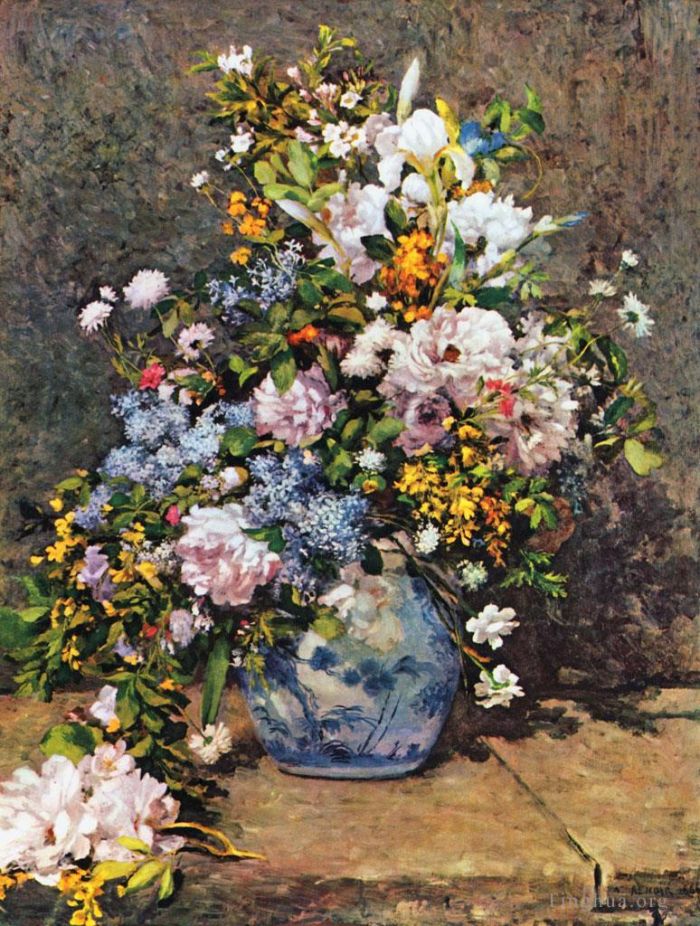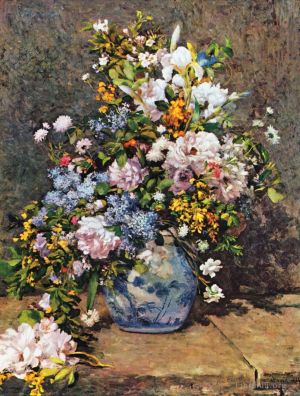Bouquet of spring flowers
Pierre-Auguste Renoir
- Price: Price on Request
- Art Type: Oil Painting
- Size:
- English Comments: 0
- International Comments: 0
- Creating Date:
- Introduction and Works of Pierre-Auguste Renoir >>
Work Overview
- Spring Bouquet
Pierre-Auguste Renoir
Date: 1866
Style: Impressionism
Period: Association with Impressionists
Genre: flower painting
Media: oil, canvas
Location: Fogg Museum (Harvard Art Museums), Cambridge, MA, US
For many French artists during the 1860s, the floral still life persisted as a test of pure painterly ability. This exuberant bouquet in a Japanese vase from early in Renoir’s career attests to the artist’s engagement with past art historical traditions. He addresses the ennobled Dutch practice of still life through the large scale of his canvas, while his attention to the textures and colors of the arrangement evokes the work of early eighteenth-century French painters like Antoine Watteau and François Boucher— artists he had studied as a teenager while working as a porcelain painter. The painting also demonstrates Renoir’s development as an artist. Instead of applying the paint with a palette knife— a technique he borrowed from artists such as Courbet— Renoir adopted a freer and thinner stroke using solely a brush.
For all its apparent looseness, this painting Spring Bouquet has a precise structure. The flowers spill over into the lower left-hand corner in joyous profusion, with an asymmetry as free and as wild as nature. But at once the artist proceeds to counter this unbalance. To the right of the vase, Renoir has developed a heavy shadow area, rich in purples, shaggy in contour, and sharply contrasted with the pool of light below it. Especially important is the placing of the ruler-straight lines in the lower right side of the canvas. In the setup from which Renoir painted there was perhaps no such line as the diagonal which breaks into a zigzag in the extreme corner; yet something of the kind is patently necessary. If the reader will cover this diagonal, he will see that the composition becomes lopsided.
This leads to an awareness of the basic structure. The composition is held in two triangles: a lower one with its apex at the rim of the bowl under the flowers; and the other with its apex at the top of the bouquet.
The Impressionist technique had not yet evolved when Renoir painted this picture. The brushing here is bold, the pigment fat and rich, suggesting the influence of Gustave Courbet. And instead of a generalized effect of luminous color, which will later suggest flowers rather than depict them, here the petals are separate and distinct.
Yet the canvas glows with light and color, indicating that Impressionism is just around the corner; there is something of that school in the feeling of the out-of-doors that Renoir has captured in this canvas. The texture of the flowers is marvelously rendered, and one is tempted to say that the very perfume of the flowers is there, too.
The silvery blue tonality is enlivened by accents of black; the lovely sprinkling of yellow starlike blossoms is sheer delight. Renoir is at the threshold of his career, but his taste already is exceptional.
- Copyright Statement:
All the reproduction of any forms about this work unauthorized by Singing Palette including images, texts and so on will be deemed to be violating the Copyright Laws.
To cite this webpage, please link back here.
- >> English Comments
- >> Chinese Comments
- >> French Comments
- >> German Comments
- >>Report
- Woman with a cat
- Irene cahen danvers
- Girl with a basket of fish
- Portrait of ambroise vollard
- The umbrellas
- The artists family
- Champs elysees paris fair
- A Girl with a Watering Can
- Bouquet of roses flower
- At the concert
- Gabrielle with bare breasts
- The gust of wind
- Mixed Spring Flowers
- Riding in the bois de boulogne
- Woman with a parasol
- Place clichy
- Young girl with a parasol
- Henry Onions still life
- Apres le bain
- Nude in the sunlight
- Girl streched out on the grass
- Daughters of catulle mendes
- The Grands Boulevards
- Jeanne samary 1878
- Woman gathering flowers
- Dance at Le moulin de la Galette
- Study Summer
- Dance at Bougival
- Young woman with a japanese umbrella
- The washer women
- The Bathers
- Young spanish woman with a guitar
- At The Theatre
- Aline and pierre
- Lanscape in la roche guyon
- Banks of the seine at champrosay
- The vintagers
- Leaving The Conservatoire
- Self portrait
- Gabrielle and jean
- Study Torso Sunlight Effect
- Reclining nude 1890
- The farm
- Monet painting in his garden at Argenteuil
- Jeanne durand ruel
- Mother anthonys inn at marlotte
- Parisiennes in algerian dress
- August madame 1872
- Madame monet lying on sofa
- La Promenade
- Luncheon of the Boating Party
- Roses in front of a blue curtain flower
- Landscape at vetheuil
- Vase of Chrysanthemums
- Gypsy girl
- Still life with flowers
- Three bathers
- The blue river
- Apples and Flowers
- Woman tying her shoelace
- Odalisque (An Algerian Woman)
- The Doges Palace
- Charles and georges durand ruel
- Woman standing by a tree
- Young girl reading
- The Dancer
- Claude Monet Reading (Reading A Newspaper)
- Girl with a Straw Hat (Young Girl in a Straw Hat)
- Portrait of richard wagner
- View of Venice Fog
- Landscape between storms
- Woman playing the guitar
- The laundress
- A box in the theater des varietes
- Fruits from the Midi
- Claude playing
- Madame charpentier
- Young woman seated
- Young Girls at the Piano
- Portrait Of The Actress Jeanne Samary
- Julie manet
- Romaine Lascaux
- Lady in a white hat
- Still Life With Bouquet
- Madame henriot
- The first step
- Terraces at Cagnes
- Gabrielle in a red blouse
- Lady with a veil
- Monsieur fournaise
- Alphonsine fournaise
- Two Girls Reading
- Landscape at cagnes
- Bouquet in front of a Mirror
- Portrait of Alfred and Marie Sisley
- Casbah
- Blonde Bather
- Girl with a basket of oranges
- The Apple Seller
- House in collett at cagnes
- After the bath
- Madame Monet and Her Son
- Railway bridge at chatou
- Path Leading through Tall Grass
- Nude on cushions
- Oarsmen at chatou
- Woman combing her hair
- Jeanne Samary in a Low Necked Dress
- Girl With A fan
- Rocky craigs at lestaque
- Portrait of alfred sisley
- Andree in blue
- Woman reading
- Maison de la poste cagnes
- Enoir picking flowers
- Gabrielle with jean and little
- Washerwomen
- La Grenouilliere
- Summer hats
- A Bather (Bather is Styling)
- Pensive
- Young woman with a dog
- Head Of A Woman
- Young woman wearing a hat with wild roses
- The Large Bathers
- Portrait of jeanne samary
- In the Meadow
- The pont neuf paris
- Marie murer
- Portrait of jean frederic bazille
- Therese berard
- Mother and children
- Strawberries
- The Seine at Asnieres (The Skiff)
- Jugglers at the cirque fernando
- Woman by a fence
- Laundresses
- The Theatre Box (La Loge)
- Flowers in a vase 1866
- Portrait of coco
- Bather with Blonde Hair
- The spring
- The canoeists luncheon
- Woman in a park
- Gabrielle with a rose
- The luncheon
- Dance in the Country
- Yvonne and christine lerolle playing the piano
- The artists son jean
- Mosque in algiers
- Woman In Black
- Sailboats at argenteuil
- Lise with an Umbrella
- Piazza san marco venice
- The parisian
- Young boy with a cat
- Portrait of a girl
- By the seashore
- La mere aux oies
- Torso Before the Bath The Toilette
- Sleeping bather
- Woman at the piano
- Girl wiping her feet
- Georges riviere
- Landscape
- Bathers 1910
- Garden in rue cortot montmartre
- Bather on a rock
- Sleeping girl with a cat
- Portrait of madame chocquet
- Portrait actress jeanne samary
- The first outing
- Nini in the garden
- A girl with a watering can Pierre Auguste Renoir
- Bather with Long Hair
- Portrait of claude monet
- Girl with a hoop
- Young girl combing her hair
- Madame and bob
- Fisherman on riverbank
- Andree in yellow turban and blue skirt
- Claude monet
- The swing
- Child With A Whip
- Regatta at argenteuil
- Anemones flower
- Peaches on a plate still life
- 5 la promenade
- Mixed Flowers In An Earthenware Pot
- Mlle charlotte berthier
- The horsewoman
- Seated Bather
- Mother and child (Motherhood or Woman Breast Feeding Her Child)
- Woman at the fountain
- Young shepherd in repose
- Diana
- Mademoiselle sicot
- The Rambler
- View of antibes
- Portrait of victor chocquet 75
- Roses and jasmine in a delft vase flower
- After the luncheon
- Jules le couer in fontainebleau forest
- Bathers
- Young woman wearing a hat
- Yvonne and jean
- Beach scene guernsey
- Woman with a mandolin
- The bather
- Dance in the City (City Dance)
- Madame charpentier and her children
- The coiffure
- Skaters in the Bois de Boulogne
- Bather Arranging her Hair
- Still life with peaches and grapes
- Claude monet reading
- Head of a dog
- Madame Renoir with a Dog
- Portrait of william sisley
- The garden in montmartre
- Madame Georges Charpentier and her Children
- At the Luxembourg Gardens
- La Grenouillere
- Young women talking
- The Pont des Arts, Paris (The Pont des Arts and the Institut de France)
- Bouquet of spring flowers
- Bernheim de villers
- Two Sisters (On the Terrace)
- The meadow
- Child in white
- Tilla durieux
- Young woman braiding her hair









 Singing Palette
Singing Palette